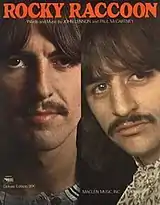| "Rocky Raccoon" | |
|---|---|
 | |
| Song by the Beatles | |
| from the album The Beatles | |
| Released | 22 November 1968 |
| Recorded | 15 August 1968 |
| Studio | EMI, London |
| Genre | Country,[1] ragtime[2] |
| Length | 3:33 |
| Label | Apple |
| Songwriter(s) | Lennon–McCartney |
| Producer(s) | George Martin |
"Rocky Raccoon" is a song by the English rock band the Beatles from their 1968 double album The Beatles (also known as the White Album). It was primarily written by Paul McCartney, although credited to the Lennon–McCartney partnership. McCartney began writing the song in Rishikesh, India, where the Beatles were studying Transcendental Meditation in the early months of 1968. John Lennon and Scottish singer-songwriter Donovan, who joined the Beatles on their retreat, also made contributions to the song.[3] A cover version by Richie Havens reached number 76 in Canada in 1969.[4]
Composition
The song, a country ballad, is titled from the character's name, which was originally "Rocky Sassoon", but McCartney changed it to "Rocky Raccoon" because he thought "it sounded more like a cowboy".[5] Former 13th Floor Elevators drummer Danny Thomas claims the name "Rocky" was inspired by Roky Erickson, the American rock band's then-vocalist and -guitarist.[6] According to Beatles historian Kenneth Womack, McCartney drew his inspiration for the song from Robert Service's poem "The Shooting of Dan McGrew".[7] Canadian photographer and filmmaker Paul Saltzman, author of The Beatles in Rishikesh and The Beatles in India, has expressed the belief that Paul McCartney based the lyrics for ‘Rocky Raccoon’ on Saltzman’s description to him in Rishikesh of his girlfriend having recently left him for another man. The Old West-style honky-tonk piano was played by producer George Martin.[8] "Rocky Raccoon" is also the last Beatles song to feature John Lennon's harmonica playing.
The lyrics describe a conflict over a love triangle, in which Rocky's girlfriend Lil Magill (known to the public as Nancy) leaves him for a man named Dan, who punches Rocky in the eye. Rocky vows revenge and takes a room at the saloon in the town where Dan and Nancy are staying. He bursts into Dan's room, armed with a gun, but Dan outdraws and shoots him. A drunken doctor attends to Rocky, who insists that the wound is only a minor one. Stumbling back to his room, Rocky finds a Gideon Bible.
Starr's accentuated snare drum after the line "He drew first and shot" (mimicking the sound of a gun) is an example of word painting.
During take 8 of the song (featured on Anthology 3), McCartney flubbed the line "stinking of gin", singing "sminking" instead (presumably confusing the words "smelling" and "stinking"). This caused him to laugh, exclaim "Sminking?!" and make up the remaining lines in the song. This take also has a noticeably different spoken-word introduction, with Rocky coming from "a little town in Minnesota", rather than the album version's "somewhere in the black mining hills of Dakota", and McCartney's faux Western-American accent is more pronounced.
Legacy
In Mojo magazine in October 2008, McCartney acknowledged that the style of the song is a pastiche, saying: "I was basically spoofing the folksinger." Lennon attributed the song to McCartney, saying: "Couldn't you guess? Would I have gone to all that trouble about Gideon's Bible and all that stuff?"[9]
Coinciding with the 50th anniversary of its release, Jacob Stolworthy of The Independent listed "Rocky Raccoon" at number 22 in his ranking of the White Album's 30 tracks. He called the song "proof of McCartney's songwriting versatility" and continued that the song is "bolstered by a vibrant honky-tonk piano from the group's long-time record producer George Martin".[10]
Personnel
According to Ian MacDonald:[8]
- Paul McCartney – lead vocals, acoustic guitar
- John Lennon – backing vocals, harmonium, six-string bass, harmonica
- George Harrison – backing vocals, bass[11]
- Ringo Starr – drums
- George Martin – honky-tonk piano
- Yoko Ono – backing vocals
References
- ↑ Stephen Thomas Erlewine. "The Beatles [White Album] - The Beatles | Songs, Reviews, Credits, Awards". AllMusic. Retrieved 30 June 2014.
- ↑ Riley 2009, p. 166.
- ↑ Miles 1997, pp. 422, 423.
- ↑ "RPM Top 100 Singles - October 25, 1969" (PDF).
- ↑ Beatles Interview Database 1968.
- ↑ "Danny Thomas Interview - 13th Floor Elevators". Texas Psych. 29 January 2009. Retrieved 2 March 2011.
- ↑ Womack 2014, p. 784.
- 1 2 MacDonald 2005, p. 308.
- ↑ Sheff 2000, p. 189.
- ↑ Stolworthy, Jacob (22 November 2018). "The Beatles' White Album tracks, ranked – from Blackbird to While My Guitar Gently Weeps". The Independent. Retrieved 27 March 2019.
- ↑ Howlett, Kevin. Abbey Road (50th Anniversary Super Deluxe Version) (book). The Beatles Apple Records.
Further reading
- Riley, Tim (2009). Tell Me Why: The Beatles: Album By Album, Song By Song, The Sixties And After. Hachette Books. ISBN 978-0-78673-090-2.
- MacDonald, Ian (2005). Revolution in the Head: The Beatles' Records and the Sixties (Second Revised ed.). London: Pimlico (Rand). ISBN 1-84413-828-3.
- Miles, Barry (1997). Paul McCartney: Many Years from Now. New York, NY: Henry Holt. ISBN 0-8050-5249-6.
- "Radio Luxembourg Interview". Beatles Interview Database. The Beatles Interview Database. 20 November 1968. Retrieved 10 June 2007.
- Sheff, David (2000). All We Are Saying. St Martin's Griffin. ISBN 0-312-25464-4.
- Carlin, Peter (2009). Paul McCartney: A Life. ISBN 978-1-4165-6209-2.
- Womack, Kenneth (2014). The Beatles Encyclopedia: Everything Fab Four. Santa Barbara, CA: ABC-CLIO. ISBN 978-0-313-39171-2.